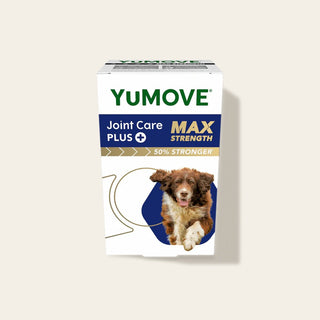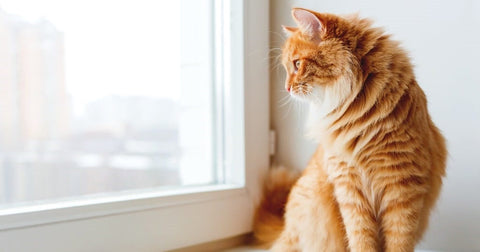

Keeping your cat's joints feline great at all ages
For those of us who share our lives and homes with a feline friend, there’s something genuinely mesmerising about their ethereal grace and elegance.
But from leaping effortlessly onto the highest bookshelf to simply stretching out for a relaxed nap in a sunbeam, each activity relies on the wellbeing of your cat's joints. So, how can you ensure your cat's joints stay in top-notch condition at every stage of their nine lives?

Joint Care PLUS for Cats
- Designed to support older and stiffer cats
- Helps keep your cat active and mobile
- Sprinkle over food or feed by hand
We caught up with cat behaviourist Lucy Hoile and TV vet Dr Scott Miller to find out.
First things first… your cat’s joint health is a big deal
Your cat’s joint health is at the heart of their extraordinary physical capabilities. These agile animals have evolved to make the most of their hunting and survival skills, typically through stealth, speed and the powerful spring of their legs. However, they may need your help to maintain this athleticism.
Depending on your cat’s age, they may benefit from household adaptations, training, or diet modifications. But you should always be alert for ways to support their mobility.

Keeping your kitten safe and active: teaching them good habits from the start
Kittens are like furry little springs, bouncing and pouncing their way through their early months. This exuberance is delightful to watch but could also get them in trouble.
“When they’re younger, it’s important to encourage a good range of motion,” says Dr Scott, advocating for active kittens everywhere.
Your kitten will, for example, love playing games with you, chasing pieces of string, and scaling the curtains or cat tree. But while the whole world looks like a playground, now’s also the time to teach them that some areas of the house are off-limits.
“There are a lot of things that are potentially dangerous in a house,” warns Dr Scott. “And it’s up to you to instil in your cat that they can’t go into certain places without being immediately removed from them – because if they were allowed complete access to everywhere, they simply wouldn’t know that – for example – the hob is hot.”
Joint care for adult cats: keeping an eye out for tell-tale signs
As your cat heads into adulthood, keeping their weight in check is a great way to support their joints.
“We see a lot of cats that are dealing with obesity – and obesity can exacerbate changes to joints,” says Dr Scott.
He advises taking proactive steps to maintain your cat’s weight – following guidance from your vet.
“This may involve changes in the nutrition you supply – to reduce the consumption of calories maybe. Because if they’re exercising less, they’re burning off less energy. So, you do want to make that slight adjustment to ensure they keep to a normal weight, and it doesn’t impact on their joints.”
Beyond calorie management, a nutritious, well-balanced diet also helps to provide your cat with essential nutrients, such as Omega-3 fatty acids, that play an important role in joint health.
Joint care for senior cats: wisdom with a touch of support
Age comes with certain challenges – including a greater chance of joint stiffness – but there are plenty of ways to support your senior cat’s joints.
“There’s no need to limit where they go,” says Dr Scott, “but I’d clock where they’re going and allow them more access, or easier access to those places. They’re smart enough to know what suits them best – so just be sensitive to that.
“For example, we’ve got a very nice warm room in our house where the boilers are, and our cat loves going in there. So, we’ve started leaving that door open to allow him to go and enjoy the warmer climes of that room over the rest of the house.
“That’s become increasingly commonplace for him as he’s got older and his joints have got stiffer.”
How to spot the signs of joint stiffness in cats
A big indicator of joint stiffness can be changes to your cat’s usual behaviour, says expert Lucy Hoile. She points to toileting outside the litter tray, increased aggression, and avoiding elevated surfaces as warning signs.
“It’s about picking up on those changes. Any change in their behaviour can be a sign, even if they’re not actively trying to tell you they’re poorly.”
If your cat is older, Lucy advises taking additional steps to help them get to their favourite places more easily.
“It’s better to be proactive with these things,” says Lucy. “If you know your cat likes to get up on the wardrobe, then don’t make them jump from the floor. Looking at the environment from their point of view can give you those clues as to what they want and need. That may be an extra step to get up onto the wardrobe – even if that’s just a box next to it – or to get onto the sofa.”
Dr Scott has already made similar adaptations for his 17-year-old cat, Rickets.
“We have made little stairs up to his food,” says Dr Scott. “We have dogs as well, so the food has to be up high, so the dogs don’t eat it, but we’ve just made it easier for him to get to it.”

Joint Care PLUS for Cats
- Designed to support older and stiffer cats
- Helps keep your cat active and mobile
- Sprinkle over food or feed by hand
Support their joints with YuMOVE’s Joint Care for Cats
When it comes to taking care of your cat's joints, YuMOVE Joint Care for Cats and YuMOVE Joint Care PLUS for Cats – our NEW high-strength cat joint supplement designed for older and stiffer cats – help to aid stiff joints, help mobility and support joint structure.
You can give your cat YuMOVE to help support their joints throughout their lives and ensure they’ve got a helping paw on their side, whatever else is happening.
Caring for your cat's joints is a commitment to their wellbeing, ensuring they remain active and happy for as long as possible. Explore our feline joint care supplements today and get 50% off the first two months and 20% off after that.**





